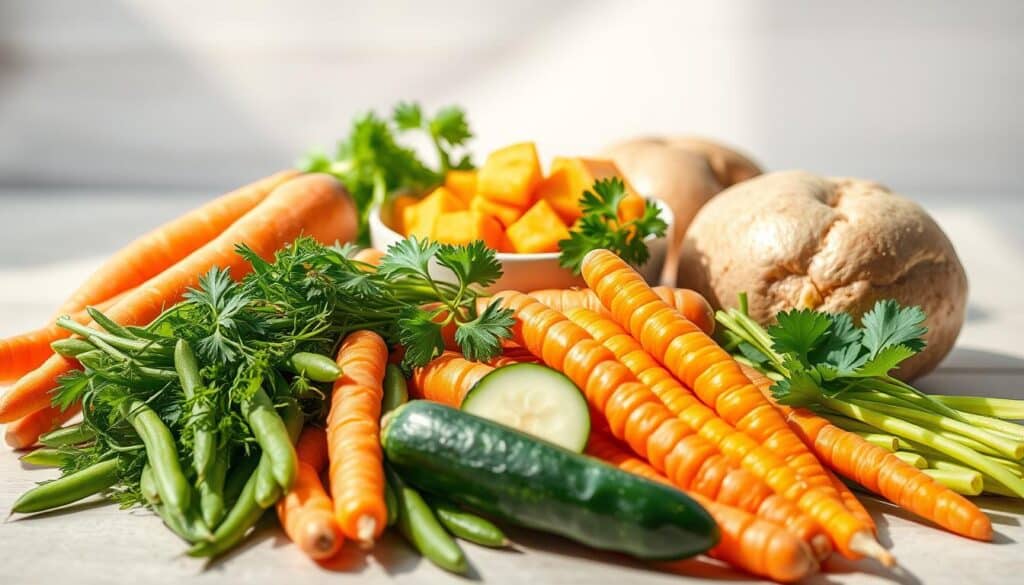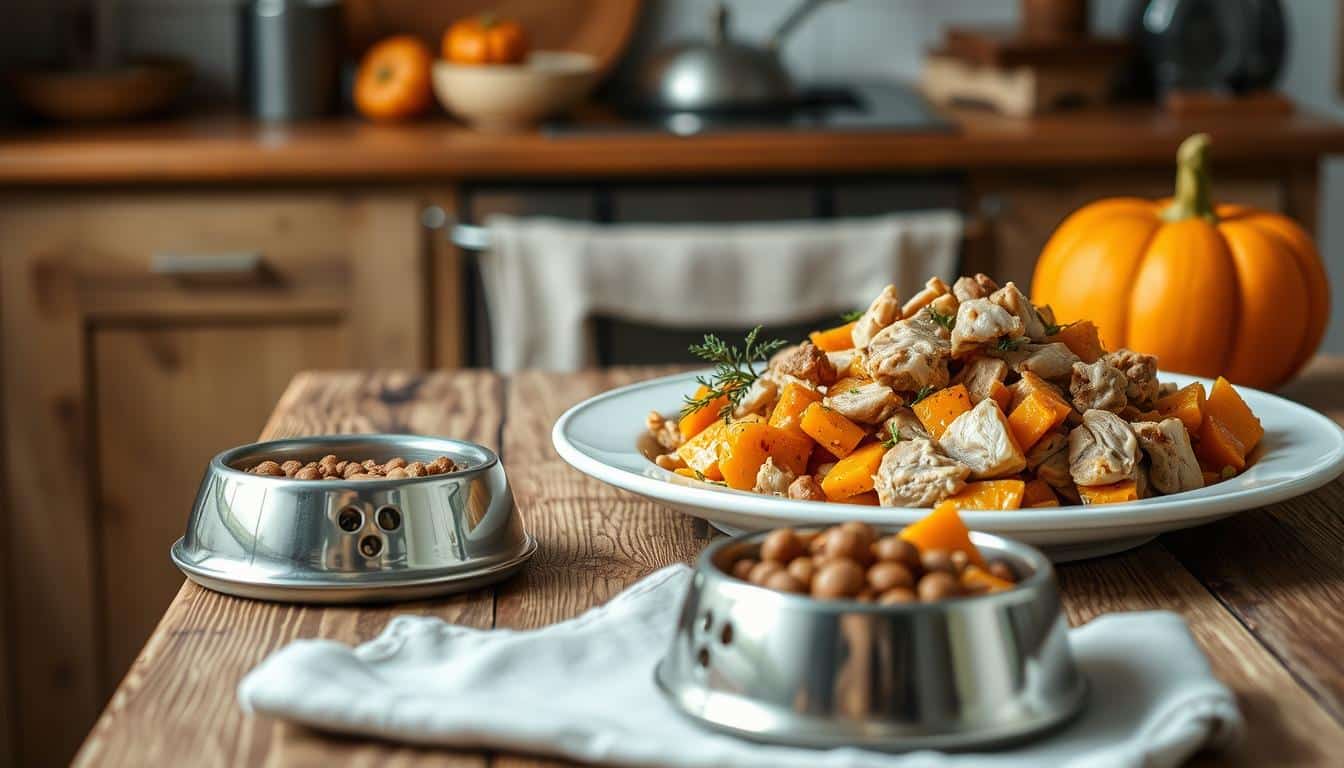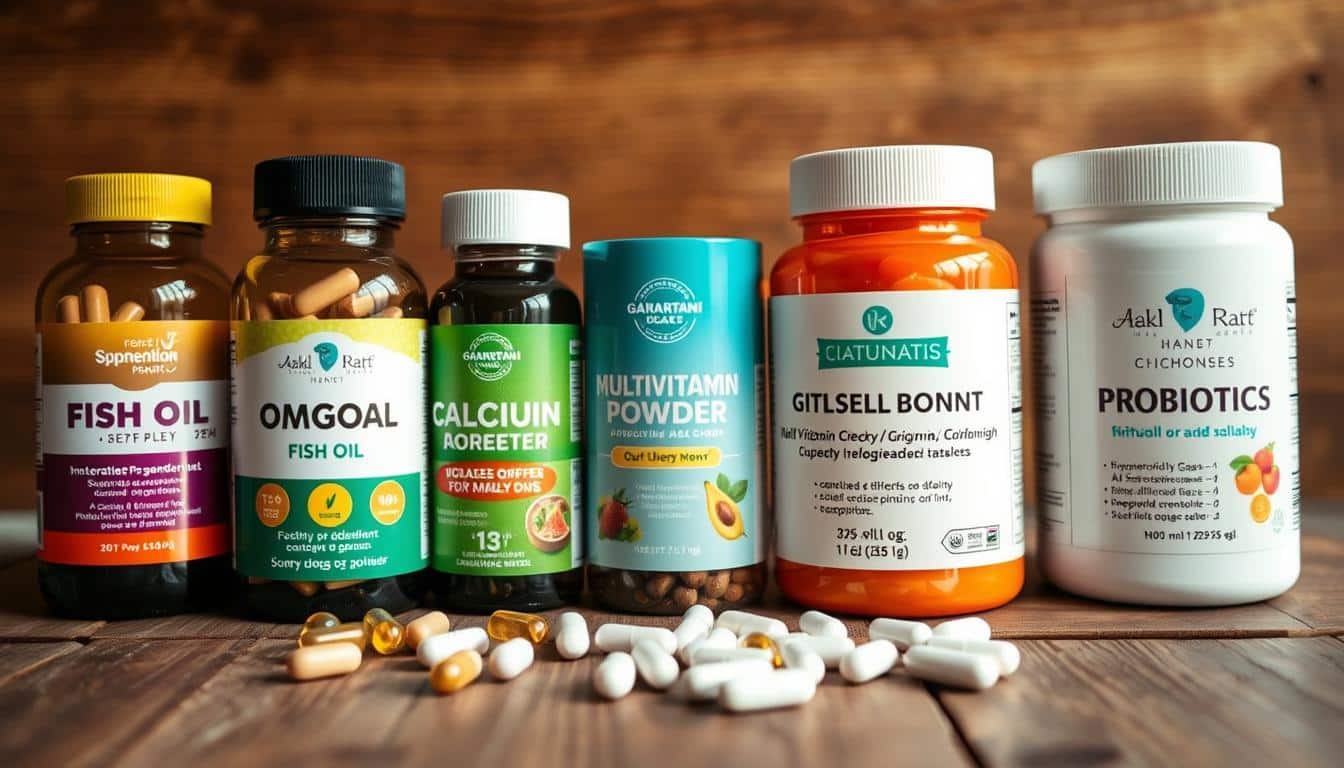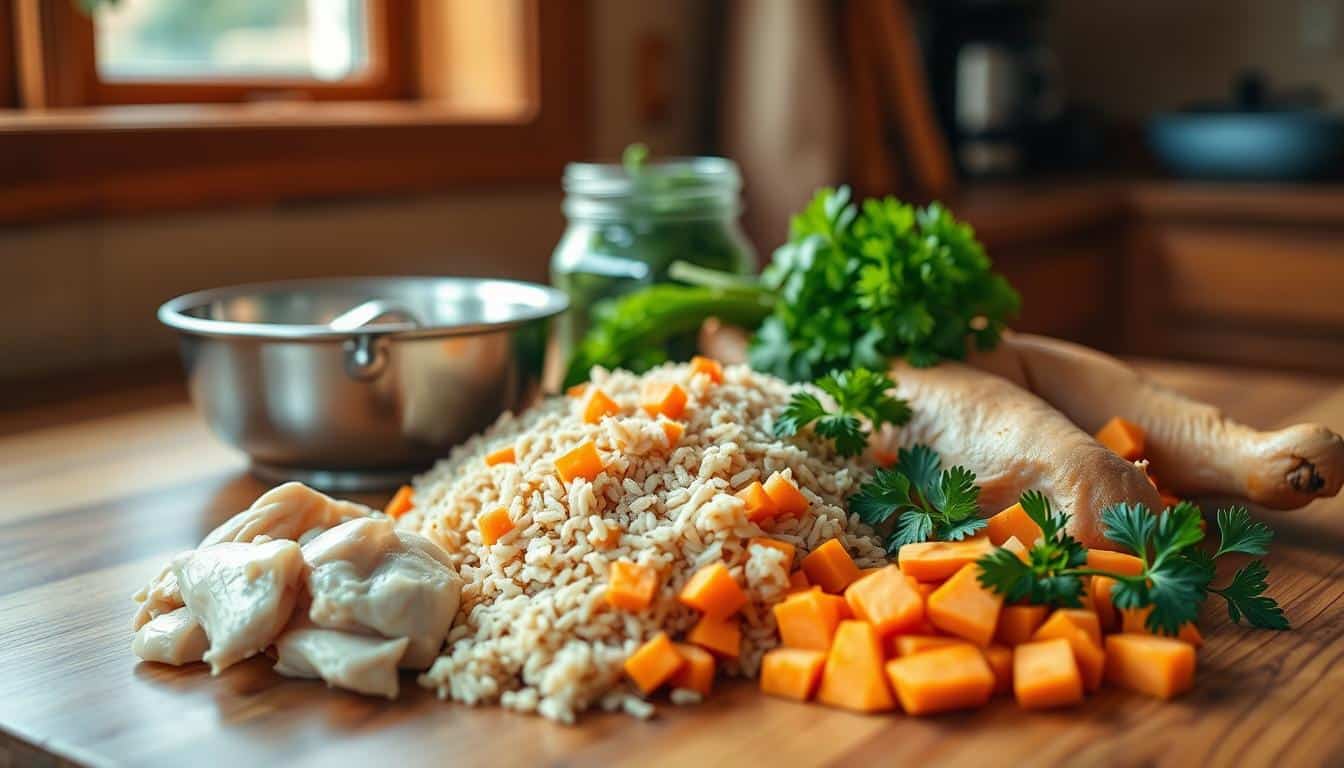This guide helps you safely add veggies to diets of dogs with food issues. It offers vet-approved tips. This way, you can pick the best veggies without worry.
Veggies can be great snacks or meal additions for dogs of all ages if you choose and prepare them right. We will explore safe options, how to introduce new foods, control portions, and cook to avoid upset.
Your dog could enjoy veggies that are low in allergens and easy to digest. This replaces treats that might cause problems. We’ll look at pumpkin, sweet potato, green beans, and more. Plus, we’ll discuss what foods to avoid, like onions and garlic.
Keep reading to learn how to safely introduce veggies and recognize if they’re not suitable for your dog.
Why vegetables help sensitive dogs: nutrition and allergy considerations
Vegetables are a soft way to boost nutrients for dogs with sensitive stomachs. They provide key vitamins, minerals, and fiber. This supports their digestion and overall health. Start with small amounts and notice how your dog reacts to new veggies.
Vegetables high in fiber, like pumpkin, green beans, and peas, help with bowel movements. Pumpkin can solidify stools and help with constipation. They also ease the pressure on anal glands. Choose plain, cooked veggies to avoid gas.
Immune support and antioxidants
Vegetables are great for giving dogs antioxidants and vitamins for their immune system. For example, bell peppers, broccoli, beets, and green leaves or vitamin C, beta-carotene, folate, and minerals. These help fix cells. Adding a little to meals can increase important nutrients without upsetting your dog’s stomach.
Weight management and low-calorie options
Vegetables can also be low-cal snacks that make dogs feel full. Try green beans, cucumbers, celery, or lettuce for weight control. They mix low calories with fiber. This helps dogs lose weight slowly without feeling hungry.
When vegetables can worsen sensitivities or interact with conditions
However, not all veggies are good for every dog. Spinach and kale, for example, could increase the chance of stones in some dogs. Carrots and sweet potatoes have more sugar. So, they’re not good for dogs with diabetes. And, peas might not be safe for dogs with certain kidney or urinary issues.
It’s also important to watch out for dog allergies to some vegetables. Stay away from veggies that have been seasoned or have garlic, onion, or xylitol. Always choose foods that fit your dog’s health history. And, talk to a vet if you’re unsure.
How to test new veggies safely for dogs with sensitivities
When introducing new veggies to dogs with sensitivities, go slowly. Start with tiny amounts. Watch their behavior and health closely. Keep a log to track reactions, making it easier for you and your vet.
Consulting your veterinarian first
Always talk to your vet before introducing veggies to your dog’s diet, especially if they have health issues or are on special diets. Your local vet can help pick safe veggies and check for medication issues.
Slow introduction and elimination monitoring
Introduce new veggies one at a time to check for allergies. Give a new vegetable for three to seven days, looking for signs like vomiting or diarrhea.
If your dog reacts badly, stop the new food and go back to their normal diet. By removing and adding foods one by one, you can figure out what causes issues.
Portion control and the 10% treat rule
Stick to the 10% rule for treats and extras, keeping them below 10% of daily calorie intake. Start with tiny amounts, like a spoonful of pureed pumpkin.
Only give more if there are no negative reactions. Small portions can prevent stomach upset and make it easier to see how your dog handles the new food.
Tracking symptoms and food journals
Maintain a detailed food journal for your dog. Note the date, time, how much you gave, and how it was prepared. Observe and log any changes in their poop, skin, hunger, and energy.
Share this journal during vet visits. It helps your vet understand how your dog reacts to new foods and decide on any diet changes.
Best vegetables for dogs with food sensitivities
For a sensitive dog, choosing safe veggies is key. Pick simple, single-ingredient veggies that are easy on the stomach and lack irritants. Stay away from canned mixes with extra salt or sugar.
Why these picks suit sensitive dogs
These veggie choices are great for dogs with food sensitivities. They’re low in allergens, easy to digest, and don’t have harsh fibers. It’s best to cook them plainly and try one type at a time. This way, you can watch for any bad reactions.
Pumpkin for fiber, stool regulation, and skin support
Pumpkin is excellent for fixing stool problems in dogs. Use plain cooked or canned pumpkin (make sure it’s not pie filling) to help with bowel movements. Begin with 1–2 tablespoons in their food and note a slight orange color in their stool.
Pumpkin is also good for a dog’s skin. It provides fatty acids that help with skin health and reduce mild inflammation. Remember to give it in small, consistent amounts.
Cooked sweet potatoes for gentle fiber and vitamin A
Cooked sweet potato is great for dogs. It offers both soluble and insoluble fiber and beta-carotene. This helps with skin and eye health. Always cook it before serving to make it easier to digest.
For dogs with weight or blood sugar issues, serve small amounts. Thin slices or mashed sweet potato can help manage their intake.
Green beans and cucumbers as low-calorie, low-risk snacks
Green beans are a fantastic choice for dogs. They provide fiber, vitamins A, C, K, and minerals like iron and calcium, all while being low in calories. You can serve them steamed or raw for a crunchy treat.
Cucumbers are great for hydration and have very little sugar. They’re perfect as training treats or meal toppers for dogs watching their weight.
Zucchini and steamed carrots for digestibility and low sugar
Zucchini is low in calories and full of vitamins A, C, and B6. It’s easy for dogs to digest when sliced or steamed. Carrots are great for their beta-carotene and crunchy texture but have more natural sugars.
For smaller dogs, steam or finely chop the carrots, and be mindful of the amount for pets with diabetes. These veggies are safe choices that keep the risk of food sensitivities low.
Safe leafy greens and portion guidance for sensitive pups
Leafy greens can make a sensitive dog’s diet richer in vitamins and fiber. But, it’s key to give them in small doses. This way, you add variety without upsetting their stomach. Stick to simple serving sizes and prep methods to avoid problems.
Spinach and kale: benefits and risks
Spinach and kale are packed with nutrients like vitamin K, vitamin A, and iron. Small doses can be good for dogs, supporting their bone health and blood clotting. But, remember to only give a little if your dog can handle it.
However, be cautious with spinach because it’s high in oxalates. These may lead to urinary issues in some dogs. Kale has similar issues due to oxalates and high calcium. Large amounts might also upset their stomach.
Serving sizes and frequency
- Small dogs: one or two raw leaves or a teaspoon of finely shredded greens per serving.
- Medium to large dogs: a few tablespoons of shredded or chopped greens as an occasional topper.
- Frequency: limit treats from leafy greens to a few times per week unless your veterinarian clears more frequent use.
Follow these guidelines to avoid giving your dog too many minerals or causing stomach issues. You might need to tweak the amount for older dogs or those on special diets.
Preparation tips to reduce risks
- Steaming or blanching softens fibers and reduces volume, making greens easier to digest.
- Shredding, chopping, or pureeing prevents choking and aids nutrient absorption for small or senior dogs.
- Always wash thoroughly to remove dirt and pesticides. Do not add salt, garlic, onion, oils, or other seasonings.
Prepare greens for your dog in simple ways to keep them safe and healthy. Begin with small servings and watch for any changes in their eating, poo, or peeing habits.
Vegetables to avoid for sensitive dogs and why
Some garden and kitchen items are risky for sensitive dogs. Learn which vegetables and plants could make them sick. Knowing what signs to look for and when to call the vet is crucial.
Allium family dangers
- Onions, garlic, chives, and shallots hurt red blood cells and may cause hemolytic anemia. Look for vomiting, diarrhea, weakness, pale gums, and feeling tired.
- Even a little over time can be bad. Contact a vet immediately if your dog eats any because it’s serious.
Wild mushrooms and unknown varieties
- Foraged mushrooms can be dangerous. Some may lead to liver failure, kidney damage, seizures, or death. View all mushroom consumption as urgent.
- Don’t give your dogs wild mushrooms. It’s risky with mushrooms of unknown types, not just the bright-colored ones.
Unripe tomatoes and tomato plant parts
- Green tomatoes and their stems have toxic nightshade compounds like solanine. They can cause stomach issues, wide pupils, fast heart rate, and tiredness.
- Keep dogs away from tomato plant cuttings or unripe fruits. If ingested, tell the vet about solanine in tomatoes.
Corn on the cob and obstruction risks
- Corn off the cob is okay in small doses. But, the cob can get stuck in the stomach or intestines, needing emergency surgery.
- Never let a dog chew on corn cobs. Remember, corn cob hazards are especially common after outdoor meals.
Also, avoid vegetables cooked with lots of salt, butter, or spices that have xylitol, garlic, or onion powder. When your dog has food sensitivities, plain, properly cooked veggies are the safest choice.
Preparation methods that reduce irritation and increase digestibility
Choosing the right prep method can make veggies easier on a sensitive stomach. Here are some tips on how to prepare vegetables for dogs. They aim to reduce irritation and improve nutrient absorption.
- Steaming vegetables retains more vitamins than boiling for a long time. Just steam them until they’re tender, then let them cool before serving.
- This method helps soften veggies like carrots, green beans, broccoli, and zucchini. It reduces the risk of choking and helps with digestion.
Boiling and pureeing
- Boiling softens hard fibers and is good for older dogs or those with dental problems. But, it might cause some vitamins to leak out into the water.
- When you puree veggies, dogs tend to like them as meal toppers or as a gentle food option. Simply blend cooked or clean raw veggies until smooth.
Safe raw choices and proper washing
- Some raw veggies are okay in small amounts, like baby carrots, cucumber slices, bell peppers, and broccoli florets.
- Always wash veggies for dogs well. Rinse them under water, remove hard strings from celery, and cut them into small pieces to prevent choking.
Freezing and pureeing for enrichment
- Frozen veggie treats are great for dogs as cool, low-calorie snacks. You can freeze green beans, peas, or carrots without sugar.
- Puree veggies and freeze them in trays. This makes easy-to-digest portions that also entertain dogs and help cool them down.
Start with small portions and watch how your dog reacts. These methods make adding veggies to your dog’s diet safe and easy. They help maintain the right balance of nutrition and texture.
Serving tips and recipes for picky or sensitive dogs
Start by slowly introducing new veggies. Small amounts can help picky dogs get used to new textures and tastes. Choose plain, cooked veggies that suit your dog’s size and ability to chew.
Simple steamed veggie mix
- Steam green beans, zucchini, and a bit of plain pumpkin or sweet potato until they’re soft.
- Then, chop them into pieces that fit in one or two tablespoons. This is perfect for a medium-sized dog’s meal.
- Change up the veggies and watch how your dog reacts. This mix keeps things gentle and tasty.
Frozen veggie treats for cooling and low-calorie enrichment
- Freeze steamed green beans, peas, or carrot slices for a crunchy, cool snack.
- Use ice-cube trays to freeze mashed pumpkin or pureed sweet potato. They’re great for hot days.
- These frozen treats are low in calories and make playtime more fun.
Pureed vegetable toppers to mask new flavors
- Blend cooked pumpkin, soft sweet potato, or zucchini with a bit of low-sodium water until smooth.
- Spread a spoonful over your dog’s food. This can help them try new proteins or textures.
- This puree is also a good choice for older dogs or those with teeth problems.
Avoiding seasonings, oils, and toxic additives
- It’s best to serve veggies plain. Avoid garlic, onion, chives, shallots, or salty dressings.
- Stay away from xylitol and anything that might have it. Keeping xylitol away from dogs is crucial.
- Don’t use butter or flavored oils. And always check the labels on human food before sharing.
Managing common side effects: gas, stool changes, and urinary risks
When you feed your dog veggies, it might help if they’re picky. But, it could also cause some short-term issues. Watch out for signs like discomfort, loose stools, pee changes, or gas in your pup. Start with small amounts and write down what happens to find patterns quickly.
Which veggies most commonly cause gas
- Broccoli, cauliflower, Brussels sprouts, and cabbage are veggies that often make dogs gassy. They have fibers that produce gas, so give them in small bites first.
- Raw beans and too many peas can bloat your dog. Cooking and mashing them helps make them safer.
- If your dog gets gassy from veggies often, stop giving them those veggies for a few days. Then see if things get better.
Monitoring stool color and consistency
- Adding new veggies to your dog’s diet may change their stool. For instance, pumpkin can make it look orange, and beets might turn their urine red or pink. Usually, these changes go back to normal in about two days.
- Keep an eye on stool changes when your dog eats new veggies. Watch for diarrhea, mucus, or blood that doesn’t stop. If these issues don’t go away, you should call your vet.
- Writing down what your dog eats can help you see how certain foods affect their stool. This way, you can figure out what to stop giving them or what to try again.
Kidney and bladder stone risk from high-oxalate greens
- Spinach and kale are healthy but have a lot of oxalates. In dogs that get stones easily, these veggies could increase the risk of crystals forming.
- For dogs that need to be careful, serve smaller amounts. Avoid giving these greens every day in big amounts, steam and chop them, and use other veggies that are safer.
- Before you add leafy greens to your dog’s meals, talk to your vet, especially if your dog has had kidney problems. Some dogs might also need to eat less of other veggies, like peas, that have a lot of purines.
Practical tips for safety
- Give small dogs a teaspoon and bigger dogs a tablespoon of the new veggie. Then watch how they react for the next 48 hours.
- Keep an eye on your dog’s poop after you change their diet. Note the color, texture, and how often they go.
- If your dog keeps having problems after eating a certain veggie, don’t give it to them for two weeks. Then, with your vet’s advice, try it again.
When medical conditions require special veggie choices
Some health issues mean we have to be careful with what vegetables our dogs eat. Always check dog food labels and ask your vet before changing their diet. Small diet tweaks can help manage blood sugar, kidney health, and weight without sacrificing yumminess.

Diabetes and high-sugar vegetables to limit
Diabetic dogs should eat low-sugar snacks. Cut back on carrots, sweet potatoes, and avoid fruits like mango. Green beans, cucumbers, or lettuce are better snack options. Always watch their blood sugar levels and talk to your vet about any changes to keep insulin doses right.
Kidney disease and low-potassium, low-purine options
Kidney issues require watching potassium and purine levels. Avoid high-potassium veggies like spinach and sweet potatoes. And, peas have a lot of purines. Your vet can help you make a dog-safe veggie list and manage how much they eat.
Weight loss plans using low-calorie vegetables
For dogs needing to lose weight, low-calorie vegetables like green beans and cucumbers are great. They fill up your dog without extra calories. Work with your vet on a diet plan that controls portions and ensures balanced nutrition. It’s important to get vet approval before starting a diet, even one based around green beans.
Prescription diets and when to avoid extras without vet approval
If your dog is on a prescription diet, stick to it strictly. Even healthy treats or veggies might mess with their treatment. Always talk to your vet before adding anything new to their meals.
- Keep a food journal to track responses and lab changes.
- Introduce any allowed vegetable in tiny amounts and watch for symptoms.
- Always prioritize the therapeutic plan provided by the clinic.
Conclusion
Vegetables are healthy, low-calorie treats that help with digestion and provide vitamins. This summary points out the best veggies like pumpkin, green beans, and sweet potato for dogs with food sensitivities. Choices should be single-ingredient and low-allergen.
Introduce them slowly and follow the 10% treat rule. Also, keeping a food journal can help track any reactions. Avoid plants from the allium family, wild mushrooms, and unripe parts of tomatoes. Also, steer clear of corn cobs and other hazards.
How you prepare veggies is key—wash, steam, boil, puree, or freeze them. This makes them easier to digest and reduces the risk of choking. For dogs with food allergies or health issues, always talk to your vet before adding veggies to their diet. This way, you can make sure the veggies are safe for them.
FAQ
Which vegetables are safest for dogs with food sensitivities?
Why is pumpkin recommended for dogs with sensitive stomachs?
How should I introduce a new vegetable to a dog with sensitivities?
How much vegetable can I feed my dog each day?
Are raw vegetables okay for sensitive dogs?
Which vegetables commonly cause gas or bloating?
Can vegetables worsen kidney or urinary conditions?
What vegetables should diabetic dogs avoid or limit?
Are leafy greens like spinach and kale safe for sensitive dogs?
How should I prepare vegetables to reduce choking and improve digestion?
Are frozen vegetables a good option for enrichment or digestion?
Which vegetables are toxic or must be avoided entirely?
Can vegetables interfere with prescription therapeutic diets?
What signs indicate my dog is reacting poorly to a vegetable?
How can I test for food sensitivities or allergies related to vegetables?
Are seasonings, oils, or dressings safe to add to vegetables?
What are easy recipes or serving ideas for picky or sensitive dogs?
When should I consult my veterinarian about feeding vegetables?
Content created with the help of Artificial Intelligence.



